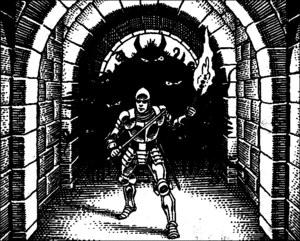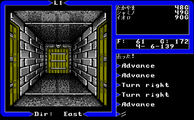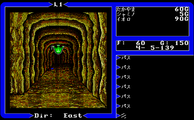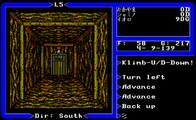Dungeon
Dungeons are deep and dark places found in the Ultima games, which are infested with monsters, and filled with treasure. In some games, dungeons also contain items needed to complete the game's main objective.
History[edit]
Ancient Dungeons[edit]
Dungeons have existed for years, though the origins of most of Sosaria’s dungeons is not known. But when Mondain attacked the lands, the dungeons started filling with all the monstrosities he created, and the treasure these creatures stole. During the First Age of Darkness, each of the four lands of Sosaria (the Lands of Lord British, the Lands of Danger and Despair, the Lands of the Feudal Lords and the Lands of the Dark Unknown) had nine dungeons each, all of them named. Most of these dungeons were never seen again after Mondain's defeat. Some the dungeons of the Lands of Danger and Despair were later turned into underground cities by the Ophidians of Serpent Isle, most notably Skullcrusher and Spinebreaker.
During Ultima II, several unnamed dungeons existed, both on Earth and on different planets of the Solar System. During this time, towers also appeared, which served the same function as dungeons, but going up instead of going down.
During Ultima III, seven dungeons existed in Sosaria (Snake Dungeon, Dungeon of Time, Dungeon of Fire, Mines of Morinia, Perinian Depths, Dardin's Pit and Mt. Doom). Several of them contained items or creatures of importance to defeat Exodus, such as the Marks and the Time Lord. However, after Exodus' defeat, they were not seen again.
The Eight Dungeons of Britannia[edit]
Starting with Ultima IV, the eight main dungeons of Britannia appeared: Despise, Destard, Deceit, Wrong, Shame, Covetous, Hythloth and the Stygian Abyss. Some of these dungeons had been originally man-made underground buildings, such as crypts, mines and prisons, while others were just caves or dwellings created by unknown powers. However, by Ultima IV, all of them had been overrun by monsters. Most of these dungeons would perdure throughout the rest of the series, up to Ultima IX. Several of these dungeons stood for an anti-virtue of the Eight Virtues of Britannia. Of these eight dungeons, only the Abyss disappeared from time to time. After the end of the Quest of the Avatar, the Abyss was sealed with the Shrine of the Codex, and only reappeared briefly in Ultima Underworld, and later in Ultima IX.
In Ultima IV, the eight dungeons were vital to complete the Quest of the Avatar, as they contained most of the Virtue Stones and the Key of Three Parts. The Abyss was the final test for the Avatar. After Ultima IV, the seven remaining dungeons were sealed by the Great Council. However, during Ultima V, the Avatar had to reopen them with the Words of Power, as they served as ways to access the newly formed Underworld. Another dungeon, Doom, appeared in the Underworld at this time, but it was lost when the Underworld was destroyed.
In Ultima IX, each dungeon contained one of the Runes, which had been corrupted into Glyphs. At each of these Glyphs, a column rose up to the surface, contaminating the minds of the Britannians with the corresponding anti-virtue.
Structure[edit]
Dungeons are composed of several levels, usually eight (except for Akalabeth, where dungeons had virtually infinite levels). Ladders are the usual way to move from one level to the next, though the spells Des Por and Uus Por can be used for the same purpose as ladders, with some limitations. The Xit spell can also be used in order to quickly exit a dungeon. These dungeon transportation spells are present until Ultima V; after that game, no equivalent spells are available.
Dungeons have many different monsters; some of them can only be found inside dungeons and not in the rest of the world. Usually, the deeper the level, the more difficult the monsters that populate it. Dungeons usually also have a sizeable amount of treasure in the form of gold, equipment, or other valuable items.
Another common feature of dungeons is their traps and puzzles. Treasure can be guarded by different kinds of traps, which, depending on the game, may or may not be disarmed. In order to advance through a level, different puzzles may have to be solved, which can range from very simple to subtle and complicated ones.
Besides treasure and some specific items needed for a main game's quest, dungeons also have other interesting things. Fountains, which have different effects on the drinker, are usually only found inside dungeons. Stat-raising items, such as the Mark of Kings and the magic orbs, are useful and an important reason to enter dungeons.
Evolution[edit]
Technical[edit]
Dungeons have evolved since their first appearance on Akalabeth. From that game up to Ultima III, dungeons, unlike the rest of the world, are seen from a first-person perspective. The transitions are static while advancing through the dungeon. Color was slowly added to dungeons as the games advanced, but it is usually very limited.
In Ultima IV and Ultima V, dungeons became first-person/top-down hybrids. While they still are first person as in previous games, these dungeons also have special "rooms", where the action goes top-down to a view similar to how the rest of the game is seen. When a room is exited, the view goes back to first-person.
Starting from Ultima VI onwards, dungeons are treated the same way as the rest of the world, and thus there is no noticeable change when entering them.
Gameplay[edit]
Dungeons in the first two games served only as a source of treasure and of monsters to be killed. In Ultima II, the substance known as tri-lithium, needed for rockets, could be found inside dungeons, but tri-lithium could also be dropped by enemies (in all but the Japanese ports), making dungeons an optional source of the material.
From Ultima III onwards, dungeons started playing a more important role in helping achieve the game's main goals. In Ultima III, some dungeons were critical as a preparation to defeat Exodus (such as getting the Mark of the Snake in Snake Dungeon and talking to the Time Lord in the Dungeon of Time). In Ultima IV, dungeons where an essential part of the game, as all of them had to be explored in order to gain the Virtue Stones and the Key of Three Parts, which were needed to finish the game. Later games started making dungeons a more integral part of the game's plot.
The endgame of the first three Ultima installments took place in the main enemy's fortress. Then, from Ultima IV onwards, dungeons were a frequent place where the end sequence would happen (the Abyss in Ultima IV, Doom in Ultima V, Hythloth in Ultima VII).
Gallery[edit]
Well-built dungeon (Sharp X68000)



